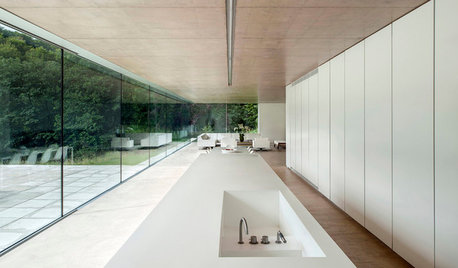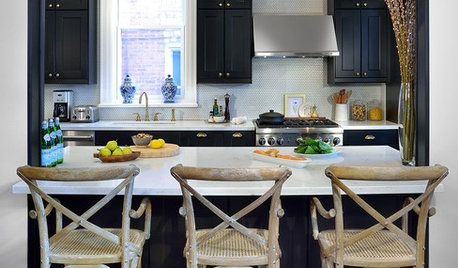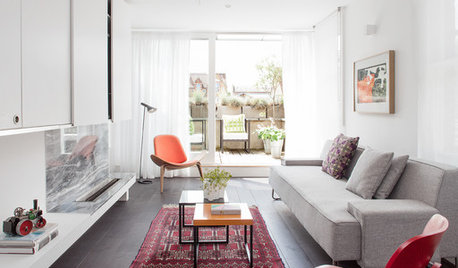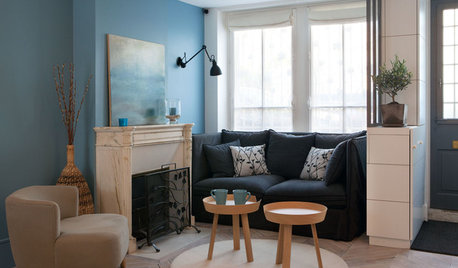but hopefully informative!
Several people have asked in my "bathroom vanity" thread how I epoxied the surface. It was way simpler than I thought it might be (and than this might make it sound!) This was the first thing I've ever epoxied, so I'm glad I didn't mess it up (much)!
I used a product called EnviroTex Lite, that someone on here recommended, and I found at a local hardware store. It can also be ordered online. There may be other brands, but I would recommend this one because I know it dries perfectly clear.
It is a two part product, a resin and a hardener. You mix one part hardener into one part resin. You whip it kind of like hand mixing cake batter, and what they don't tell you on the insert is that it will produce tiny bubbles that float into the air as you whip it. Not a problem. You mix it like this for two minutes, and it gets kind of frothy. You then pour it on your project, which really needs to be perfectly level. My vanity isn't, and I got a deep spot on one corner. You use a piece of stiff paper (or part of the instructions folded several times if you forget to have the "stiff paper" handy like I did!) to push the epoxy around on the project. Then, you breathe on it! Ok, that makes me chuckle just typing it, but it's true! Tiny bubbles appear all over, and carbon dioxide makes them pop and disappear. So I probably spent 45 minutes (felt like it anyway) exhaling gently on it. I just kept doing it until I didn't see any more bubbles pop when I did it. Actually they are so tiny after a while that you just kind of see the surface "change" as you exhale on it. I wound up using a piece of pvc pipe to blow through to save my back, and I did get a little light headed. (The directions say you can also use a small torch somehow, but I don't have one.) I may have gone overboard too. I just REALLY didn't want any bubbles. And I wound up with them anyway where it got too thick.
About the masking tape. When I did the sides and front panel, I placed them laying flat on blocks of wood on a table protected with plastic. So the epoxy just ran off the sides, or I ran it off the sides with my "stiff paper". When it was dry, there were little bumps all around the backside where the epoxy had dried in hard drips. These came off really easily with a belt sander. (You don't just scrape them off though. It's hard as a rock when dry.) (Oh, and I made sure the blocks weren't close enough to the edge to get epoxied TO my project!)
I was getting to the masking tape...I did the countertop the first time just like I did the sides and front, except without the blocks, I just let it run right down the sides of the frame. (I did protect the floor!) After the sides and front were attached, I wanted to epoxy it again so I wouldn't have a seam all the way around where the top met the sides and front. And I didn't want drips down the sides and front. So I created a "form" all around the edge with masking tape, placing it so about half the tape was stuck to the vanity and the other half sticking up above it. Basically just ran a strip of tape from one side at the back all the way around the edge to the other side at the back. I DID find, because it wasn't level, that I had to reinforce the side and corner that the epoxy was running to, as the tape started to bend over from the pressure. I also made tape "trusses", placing strips of tape connected to the edge of the sink out to the tape on the edge of the vanity. (If that doesn't make sense, ask me to clarify it.) I thought I would have to SAND off the masking tape where it was in contact with the epoxy, but lo and behold, it peeled right off! Maybe it wouldn't a few days later, but it did the next afternoon.
With the leftover epoxy, I painted the backsplash so it would have the same shine and sealant property.
I had a couple runs where the epoxy escaped under the masking tape (gotta press it down REALLY well), but I caught them while they were still wet (read "extremely sticky"!) and was able to wash them off with alcohol (and lots of elbow grease). Once it's dry, they're permanent short of sanding, which turns it whitish. BUT if you have to sand like I will where it got too deep, you are supposed to be able to go back with another layer and make it clear again.
Ok, I think that pretty much tells it. I do love the result I got, extremely smooth, even brighter color except where it got too deep, glassy shiny. I'd recommend trying it on a smaller project first, probably less nerve wracking, though it really wasn't bad.
Veronica
















shrty411
ladyronnieOriginal Author
Related Professionals
Conyers Window Contractors · Emeryville Window Contractors · Glen Burnie Window Contractors · Glendale Heights Window Contractors · Piedmont Window Contractors · Sudbury Window Contractors · Vero Beach Window Contractors · Herndon Custom Closet Designers · Odenton Custom Closet Designers · Hinsdale Custom Closet Designers · Dallas Window Contractors · Kuna Window Contractors · Lakewood Window Contractors · Mableton Window Contractors · South Laurel Window Contractorstexaswild
nicethyme
diytrying
lyndalu
brendak_59
mosaicwench1
ladyronnieOriginal Author
ladyronnieOriginal Author
brendak_59